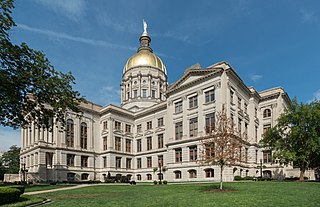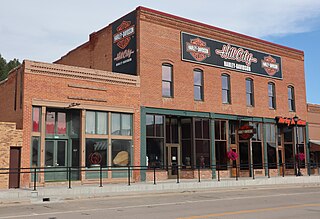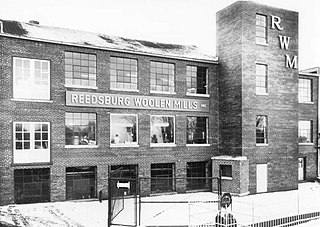
Lehi is a city in Utah County, Utah, United States. It is named after Lehi, a prophet in the Book of Mormon. The population was 75,907 at the 2020 census, up from 47,407 in 2010. The rapid growth in Lehi is due, in part, to the rapid development of the tech industry region known as Silicon Slopes. The center of population of Utah is located in Lehi.

The Financial District of Lower Manhattan, also known as FiDi, is a neighborhood located on the southern tip of Manhattan in New York City. It is bounded by the West Side Highway on the west, Chambers Street and City Hall Park on the north, Brooklyn Bridge on the northeast, the East River to the southeast, and South Ferry and the Battery on the south.
Monocacy National Battlefield is a unit of the National Park Service, the site of the Battle of Monocacy in the American Civil War fought on July 9, 1864. The battlefield straddles the Monocacy River southeast of the city of Frederick, Maryland. The battle, labeled "The Battle That Saved Washington," was one of the last the Confederates would carry out in Union territory. The two opposing leaders were General Jubal Early, fighting for the South, and General Lew Wallace, fighting for the North.

The Georgia State Capitol is an architecturally and historically significant building in Atlanta, Georgia, United States. The building has been named a National Historic Landmark which is listed on the National Register of Historic Places. As the primary office building of Georgia's government, the capitol houses the offices of the governor, lieutenant governor, and secretary of state on the second floor, chambers in which the General Assembly, consisting of the Georgia State Senate and Georgia House of Representatives, meets annually from January to April. The fourth floor houses visitors' galleries overlooking the legislative chambers and a museum located near the rotunda in which a statue of Miss Freedom caps the dome.

The Century Association is a private social, arts, and dining club in New York City, founded in 1847. Its clubhouse is located at 7 West 43rd Street near Fifth Avenue in Midtown Manhattan. It is primarily a club for men and women with distinction in literature or the arts. The Century Association was founded by members of New York's Sketch Club; preceding clubs also included the National Academy of Design, the Bread and Cheese Club, and the Column. Traditionally a men's club, women first became active in club life in the early 1900s; the organization began admitting women as members in 1988.

Vernon Court is an American Renaissance mansion designed by architects Carrère and Hastings. It is located at 492 Bellevue Avenue, Newport, Rhode Island, on the Atlantic coast of the United States. The design is loosely based on that of an 18th-century French mansion, Château d'Haroué.

The Great Atlantic and Pacific Tea Company Warehouse is a historic formerly commercial building at 150 Bay Street in Jersey City, Hudson County, New Jersey, United States. Built as a warehouse for The Great Atlantic & Pacific Tea Company (A&P) in 1900, it is the major surviving remnant of a five-building complex of the nation's first major grocery store chain. It was designated a National Historic Landmark in 1978, and now houses a mix of residences and storage facilities.

The Peter Parker House, also known as the former headquarters of the Carnegie Endowment for International Peace, is a historic row house at 700 Jackson Place NW in Washington D.C. Built in 1860, it is historically significant for its association with the Carnegie Endowment, whose headquarters it was from its founding in 1910 until 1948. The building was declared a National Historic Landmark in 1974. It has since been incorporated into the Blair House complex serving high-profile official visitors to the capital.

Gambrill House, also known as Boscobel House and Edgewood, is a house near Frederick, Maryland in the Monocacy National Battlefield. It was listed on the National Register of Historic Places in 1985.

This is a list of the National Register of Historic Places listings in Anne Arundel County, Maryland.

Herschell Carousel Factory Museum is a historic carousel factory building located at North Tonawanda in Niagara County, New York. The factory complex was constructed between about 1910 and 1915 and consists of six primary structures and five contributory additions. The primary structures are: the Mill Building, Carving and Pattern shop, Paint Shop and Storage Building, Roundhouse, Machine Shop (1915), and Assembly and Testing Building (1915). Also on the property is the Special Number One Three Abreast portable carousel, built in 1916.

The Commercial Historic District in Potlatch, Idaho was listed on the National Register of Historic Places in 1986. In 1986, it included seven contributing buildings and a contributing object. It includes work by architect C. Ferris White and work by A.M. Homes.

This is a list of the National Register of Historic Places listings in Lac qui Parle County, Minnesota. It is intended to be a complete list of the properties and districts on the National Register of Historic Places in Lac qui Parle County, Minnesota, United States. The locations of National Register properties and districts for which the latitude and longitude coordinates are included below, may be seen in an online map.

Montgomery Park is an office building and former Montgomery Ward mail-order catalog warehouse and department store located in Portland, Oregon, United States, built in 1920. It is listed on the National Register of Historic Places under its historic name Montgomery Ward & Company Building. The building is located on property once used for the Lewis and Clark Centennial Exposition, of 1905. It was occupied by Montgomery Ward from 1920 until 1985, although the majority of the company's operations at this location ended in 1982. The building is the third-largest office building in Portland with 756,055 square feet (70,239.8 m2).

The Rapid City Garage is a historic two-story building in Rapid City, South Dakota. It was built in 1911. The second floor was initially a hotel and later a nursing home until 1965. The building has been listed on the National Register of Historic Places since August 1, 1984.

The C.E. McEachron General Merchandise is a historic two-story building in Hill City, South Dakota. It was built in 1902 by Charles E. McEachron, an investor who also owned the local bank. McEachron was born in New York state in 1855 and he moved to the Dakota Territory as a pioneer in 1880; he died in 1939. The building has been listed on the National Register of Historic Places since June 3, 1994.

The Missouri Lumber and Mining Company (MLM) was a large timber corporation with headquarters and primary operations in southeast Missouri. The company was formed by Pennsylvania lumbermen who were eager to exploit the untapped timber resources of the Missouri Ozarks to supply lumber, primarily used in construction, to meet the demand of U.S. westward expansion. Its primary operations were centered in Grandin, a company town it built starting c. 1888. The lumber mill there grew to be the largest in the country at the turn of the century and Grandin's population peaked around 2,500 to 3,000. As the timber resources were exhausted, the company had to abandon Grandin around 1910. It continued timber harvesting in other parts of Missouri for another decade. While some of the buildings in Grandin were relocated, many of the remaining buildings were listed on the National Register of Historic Places in 1980 as part of the state's historic preservation plan which considered the MLM a significant technological and economic contributor to Missouri.

The Reedsburg Woolen Mill was a historic woolen mill along the Baraboo River in Reedsburg, Wisconsin. The woolen mill was the largest employer in Reedsburg for much of its life, employing over 200 people. The woolen mill was built in 1891 and lasted until 1968, when most of it burned down, leaving the office building intact. It was added to the National Register of Historic Places in 1984.

Rapid City Fruit Company is a historic commercial building at 320 7th Street in Rapid City, South Dakota. It was built in 1920 and was the first refrigerated warehouse in the city. It was listed on the National Register of Historic Places in 1993.





















